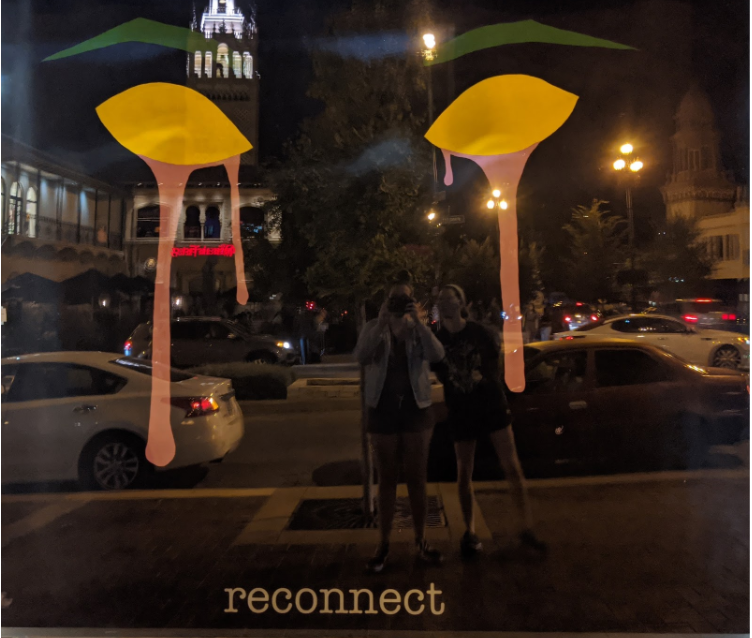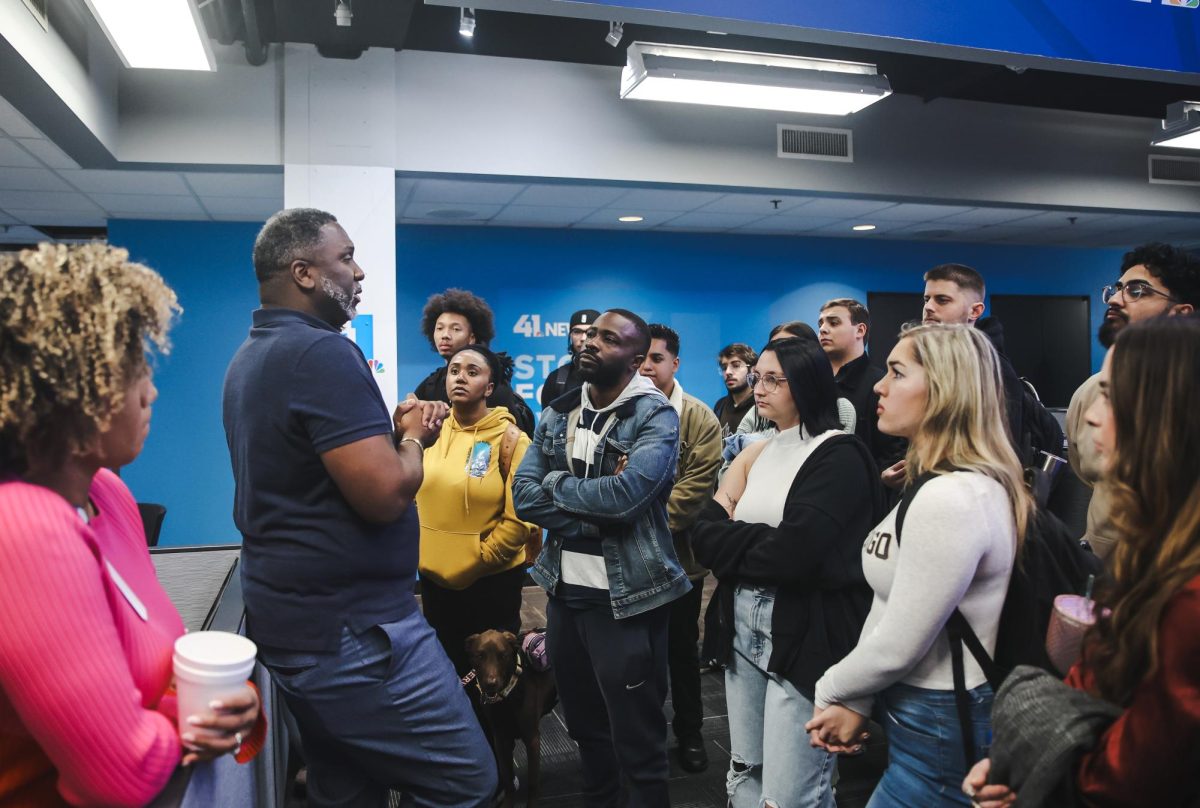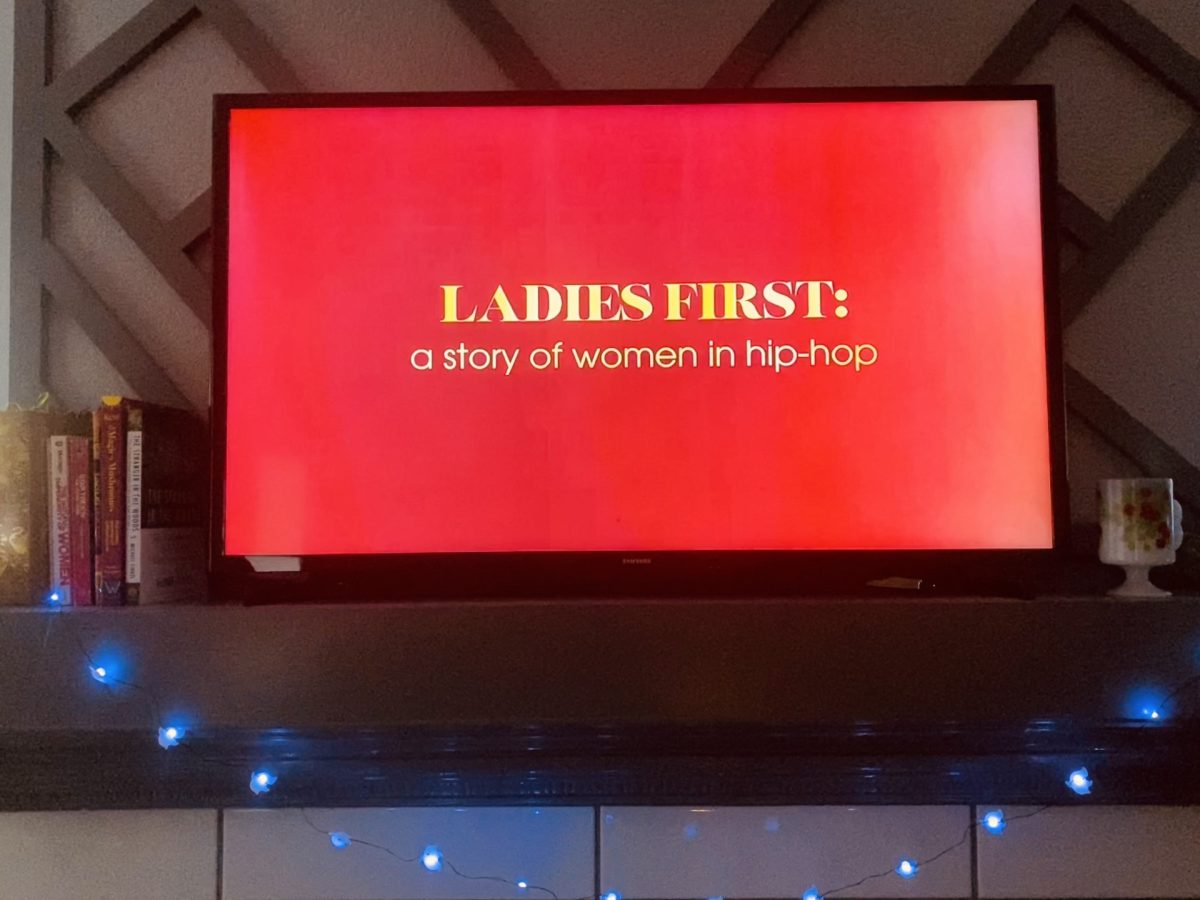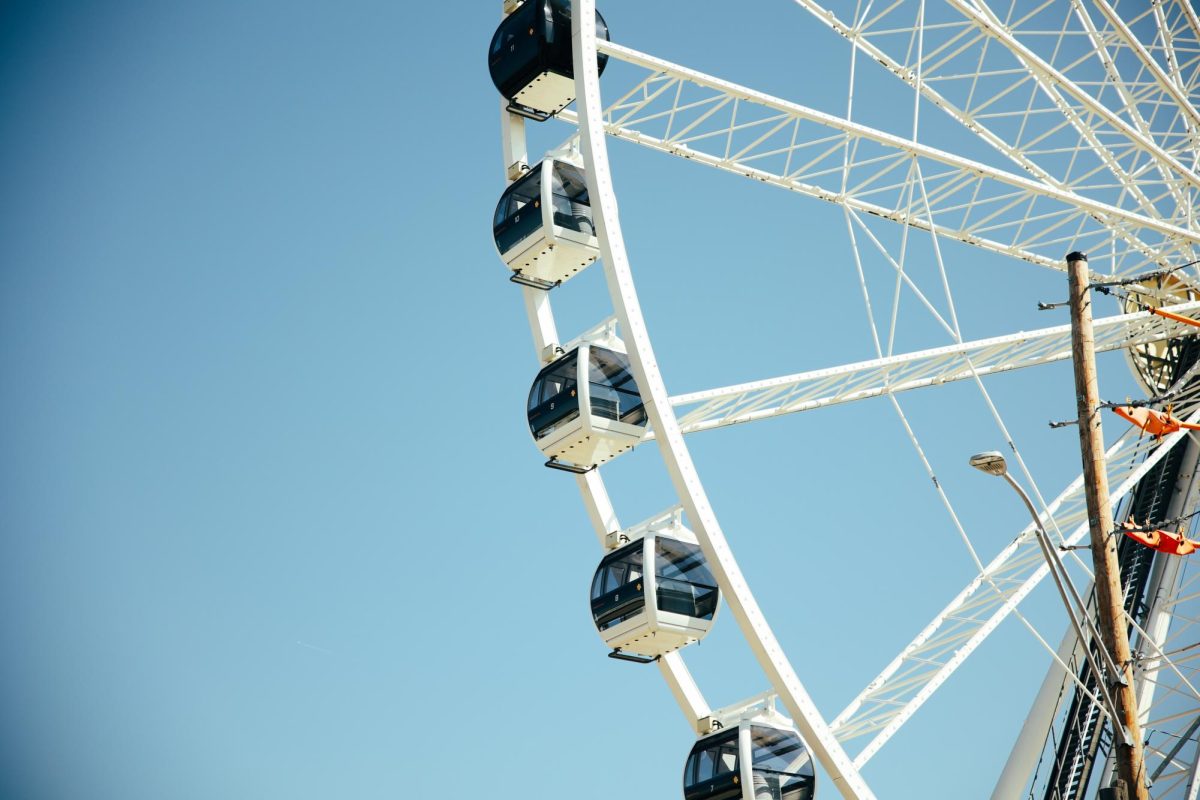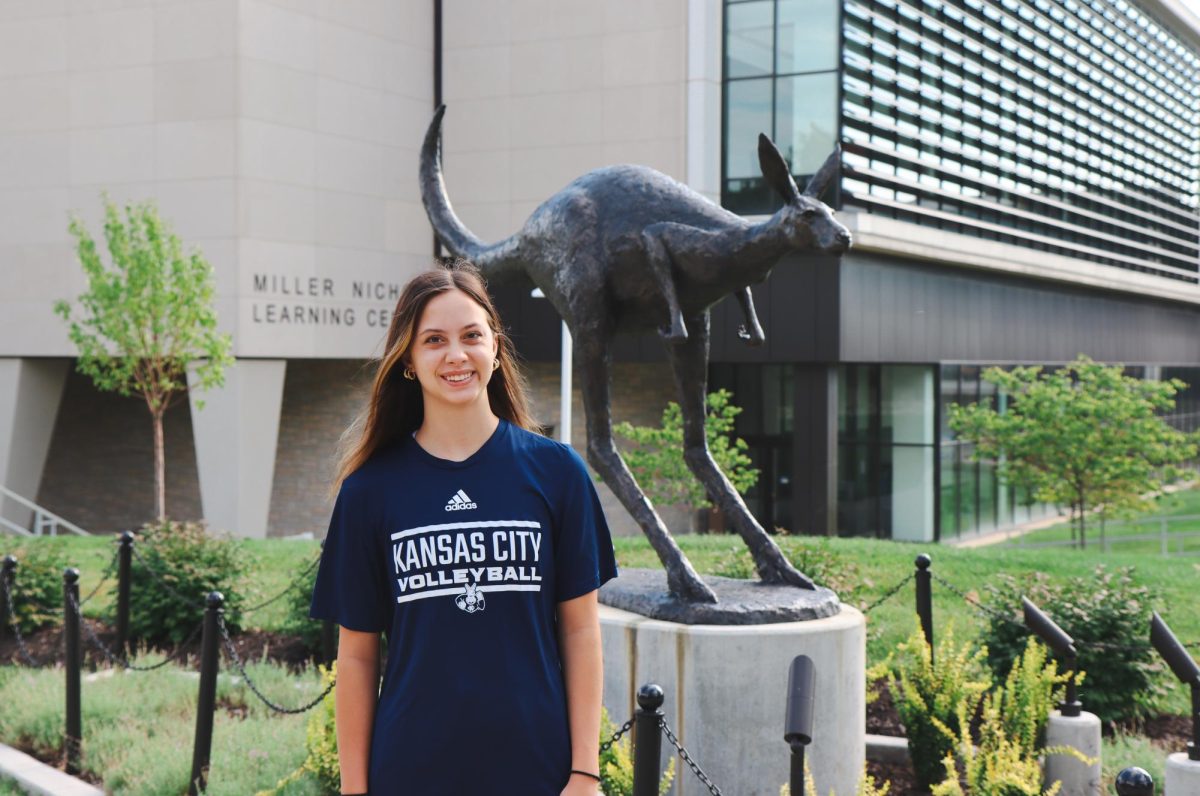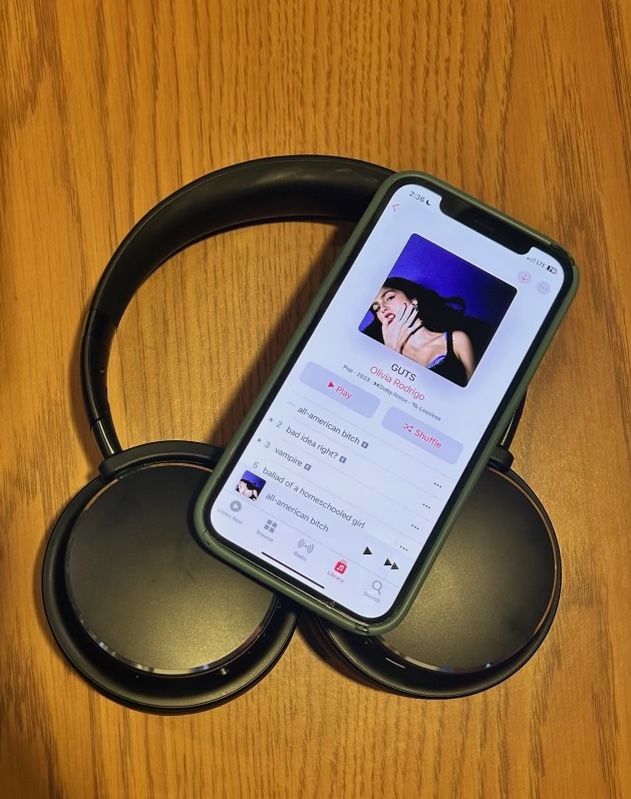The artwork was a massive field of black, taking up an entire pane of the RE’s many windows. Two almond-shaped, mustard-yellow eyes glowed out of the top of the frame. The eyes were topped by two green eyebrows, and muted pink tears streamed down from the eyes.
The artwork was striking. I peered through the glare on the glass to read the name of the artist, a Black woman named Onnissia. As I went to take a picture of the piece, I saw myself reflected in the window, made visible by the large black space of the artwork. The Giralda, one of the landmark towers of J. C. Nichols Country Club Plaza, was reflected above the left eye, glowing white through the darkness of both the painting and the night.
I looked at the painting, listening to a Black musician playing a saxophone rendition of “September” for the enjoyment of the pedestrians and customers waiting for their tables at the Cheesecake Factory. These Black artists were making the Plaza their gallery and their stage.
The third weekend after Labor Day would usually be the Plaza Art Fair, an event held every year on the Plaza sidewalks where artists from across the country come to display their art. Due to COVID-19, the “traditional aspects” of the fair were cancelled. In place of the fair, however, there are community art displays in storefronts throughout the Plaza, which contain works made by over 20 local and regional artists.
The event began just nine years after the Plaza opened as a way to draw customers to the shopping center. The Plaza was designed by J. C. Nichols, the same man who put “racially restrictive clauses into the deed restrictions on all the properties he sold,” according to the article “J.C. Nichols And The Country Club District: Suburban Aesthetics And Property Values” by Sara Stevens. This racism extended to the Plaza, which was designed explicitly for the enjoyment of white shoppers.
The next day, Saturday, September 26th, after I first witnessed the piece with the crying yellow eyes, I decided to go back to look at the art again, as well as get the name of the piece. As I drove around the Plaza, struggling to find a spot, I noticed a small Biden-Harris support rally across the street at Mill Creek Park, the site of the Black Lives Matter protests in late May and early June.
I found out that the piece was titled Lacrymosa. As I walked around the perimeter of RE, the sun beat down and the smell of sewage drifted up from under the sidewalks. I found paintings by Michael Toomb and Harold Smith, who designed murals for KC Art on the Block. Their pieces can be found at 31st and Troost and at Northwest Briarcliff Parkway and North Mulberry Drive, respectively.
I was struck by the welcoming of these Black artists into a storefront of a shopping center that was famously not built for them.
I saw Onnissia herself doing a live painting in the window of the store. I watched for a bit and then left to look at some of the other exhibits, circling back around to check her progress.
I looked back in the window, this time catching eyes with her and smiling. She turned away, back to work on her painting, and I continued examining the art in the window. I heard the sound of long continuous horns in the distance, and didn’t think much of it at first. This is Kansas City, after all.
But the horns didn’t stop, and shouting and loud music soon accompanied them, along with the revving of motorcycles. I turned around to find myself face to face with a Trump car parade.
If you’ve never experienced the atmosphere of a Trump car parade, they are specifically designed to scare people who disagree with them. The Biden rally in the park consisted of people holding signs and sitting in lawn chairs, an unintimidating way of expressing their beliefs to pedestrians and people driving by. Even at the Black Lives Matter protests, people came on foot to express their displeasure with continuous police oppression. Trump car parades take place in cars in order to make their numbers larger, and because they can drive up in machines big enough to run someone over. The parade is designed to emphasize power on the side of Trump supporters and helplessness on the side of everybody else.
I walked towards Mill Creek Park and the small Biden rally, where people were standing at the side of the road holding signs declaring “Black Lives Matter” and promoting the hashtag “Defeat Facism.” Trump supporters leaned out of the windows of their cars, shouting obscenities at the Biden and Black Lives Matter supporters.
One lady leaned out of a red pickup truck and yelled, “The unemployment’s about to run out!” I guess Trump supporters don’t realize that people without privilege are forced to have jobs.
Even as RE on the Plaza, in partnership with the Troost Market Collective, hosted a “Restoration Art Walk” featuring works exclusively by Black artists for this year’s modified art fair, symbolizing progression by literally welcoming artists into Plaza stores, white supremacy had to make itself known.
I had to take this into account with my warm feelings towards the Troost Market Collective’s exhibit on the Plaza. At first, my piece was about how the exhibit and the promotion of Black artists in the shopping center served as a shirking of the ideology of J. C. Nichols. The presence of so many Trump supporters intending to display their everlasting white power serves as a reminder that not all that much has changed.
As a white person, it can be tempting to see small, positive steps like the Troost Market Collective’s exhibit and think that things are better. Things aren’t better, though, and they won’t be until we grab the roots of the white supremacist structures implanted in the United States of America and tear them out.
The Trump car parade continued, circling the Plaza and heading up Main Street over and over again. While this display of white supremacist ideals went on, Onnissia continued creating, as Black artists have always done. Lacrymosa is not a symbol of change. It is literally a portrayal of the ongoing pain of Black people in the United States, placed in an environment where people very much need to see it and understand.
knwhf2@mail.umkc.edu


